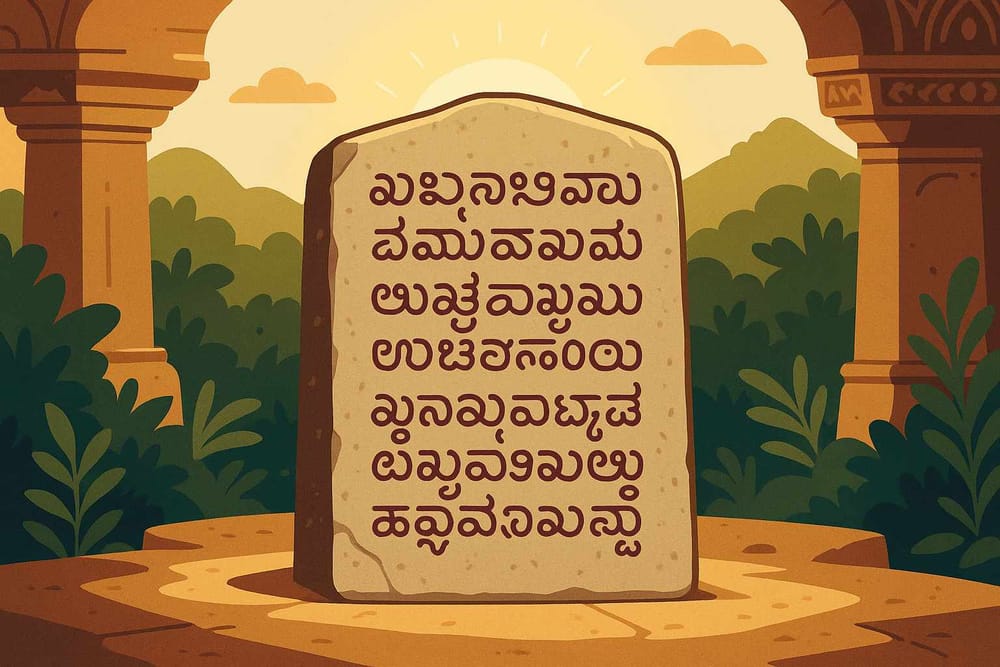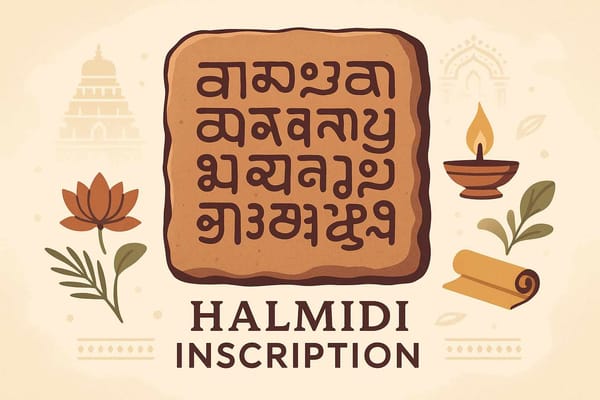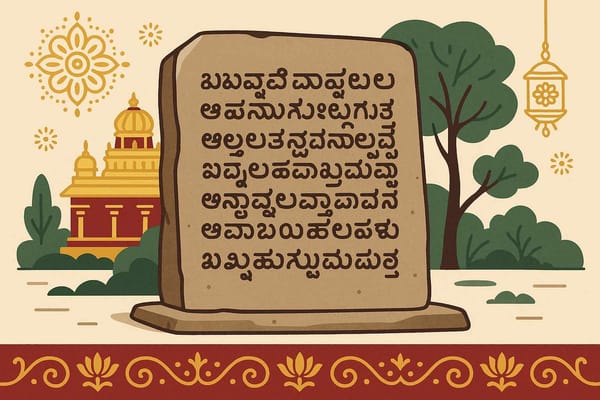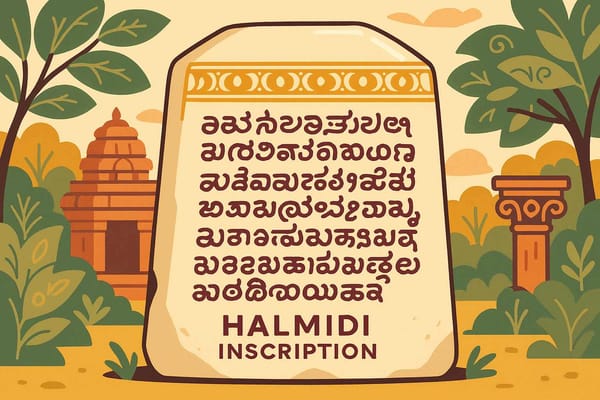
Halmidi Inscription: Kannada Script Emerges
Imagine walking through a quiet village in Karnataka, the air filled with the scent of wet earth and history. You come across an old stone, unassuming at first glance. But what if that stone could talk? What if it held the very first words of your language, written down for the first time? For the Kannada language, this isn't just a story; it's the reality of the Halmidi inscription, a discovery that changed our understanding of South Indian history forever.
This isn't just about an old rock. It’s about the moment a spoken tongue, full of life and emotion, found its written form, its ‘lipi’. It’s the story of how Kannada began its journey through the ages, and it’s a story every Indian who cherishes their heritage should know.
A New Dawn for Kannada: The World of the Kadambas
Let's travel back in time to around 450 AD. The powerful Kadamba dynasty was ruling, and they were true patrons of local culture. Until then, Sanskrit was the language of the elite, the language of administration and poetry. But the Kadambas did something revolutionary—they began to give Kannada, the language of the common people, a royal stage. They saw that for governance to be truly effective, it had to speak the language of the land.
This was a pivotal moment. By using Kannada in official records, the Kadambas weren't just communicating orders; they were weaving a sense of identity and pride. They were laying the foundation for a linguistic heritage that would flourish for centuries. This nurturing of local language is a beautiful example of how royal traditions shape local celebrations and preserve heritage, a practice that has kept our culture alive.
More Than Just a Stone: The Voice of Ancient Life
In those days, inscriptions like Halmidi were the official gazettes, the land records, and the public announcements all rolled into one. Carving a message on stone meant it was permanent, a promise etched for eternity. These stones documented everything from land grants given to warriors to donations made to temples, offering us a precious window into the society of that time.
The Halmidi inscription, in particular, is a record from the court of the Kadamba King Kakustman. It tells a story of victory, loyalty, and reward. By reading it, we don't just see ancient script; we feel the pulse of a kingdom that valued its people and its language.
Is Halmidi Truly the First? A Deeper Look into Kannada's Roots
For many years, the Halmidi inscription was celebrated as the absolute oldest record of the Kannada language. It was our 'ground zero'. However, the beautiful thing about history is that it is always revealing more of its secrets. In recent times, archaeologists have unearthed other, even older fragments of Kannada's past.
- The Talagunda Inscription: Discovered near Shivamogga, a lion balustrade inscription has been dated to 370 AD, pushing the timeline back even further. It shows that Kannada was already being written before Halmidi.
- Other Whispers from the Past: Scholars have also found inscriptions like the one by Western Ganga King Kongunivarma Madhava (around 350 AD) and the Gunabhushitana Nishadi inscription, which might be older still. These discoveries are like finding earlier chapters to a book we thought we knew completely.
So, does this make the Halmidi inscription less important? Absolutely not. While other inscriptions may be older, Halmidi remains the first known full-length, comprehensive stone edict in Kannada. It showcases a developed, structured language being used for complex administrative purposes. It remains the foundational pillar upon which our understanding of Kannada's literary and official journey is built.
A Legacy Carved in Stone: Why Halmidi Inspires Us Today
The discovery of the inscription in Halmidi village was a moment of immense pride. It provided concrete proof of Kannada’s ancient roots, placing it among India's classical languages with a rich, documented history. Its script, a beautiful evolution from the ancient Brahmi script, tells a story of adaptation and innovation.
Today, this priceless artefact is carefully protected by the Archaeological Survey of India and rests in Bangalore's Government Museum. It serves as a powerful symbol of Karnataka's vibrant heritage. It reminds us that our language is not just a tool for communication but a living bridge to our ancestors. It is a testament to the vibrancy of Indian culture and its deep spiritual roots.
This single stone connects us to a time when our identity was being forged, one carved letter at a time. It inspires pride in the hearts of millions of Kannada speakers and stands as a reminder of the enduring power of language to unite and define a people.
Connecting with Our Roots Through Bhaktilipi
Just as the Halmidi inscription preserves the heritage of a language, at Bhaktilipi, we are passionately dedicated to preserving and sharing our timeless devotional heritage. We believe that stories of our gods, the wisdom of our saints, and the beauty of our rituals are treasures that deserve to be cherished and passed on.
Our platform offers a space to explore authentic devotional literature and stories that connect you to your roots in a way that feels personal and meaningful. If the story of a stone that holds the soul of a language moves you, imagine the wisdom waiting for you in the sacred texts we have lovingly preserved. We invite you to explore this journey with us.
Stay connected with our efforts to keep tradition alive in the digital age. Follow us for a daily dose of inspiration and cultural richness:
Honouring a Timeless Journey
The Halmidi inscription is more than an archaeological find; it is a cultural heirloom. It embodies the spirit of a time when a regional language stepped out of the shadows and into the light of written history. It teaches us to cherish our linguistic treasures and to take pride in the long, beautiful journey they have travelled.
Let this ancient stone inspire us to listen to the stories our heritage tells us and to ensure that these stories are heard by generations to come. After all, our traditions are not relics of the past; they are the roots that give us strength in the present.
A passionate group of people dedicated to preserving India's knowledge of Dharma, Karma, and Bhakti for ourselves and the world 🙏.
Comments
Related in

Understanding the Halmidi Inscription: Examines India's Oldest Kannada Script
Have you ever held an old letter from your grandparents? The faded ink, the delicate paper, it feels like you're holding a piece of their soul, a direct connection to your roots. Now, imagine finding a letter not from a grandparent, but from our ancestors who lived over

Halmidi Inscription: Kannada Literature's Dawn Explored
Imagine walking through a quiet village in Karnataka, the air filled with the familiar sounds and smells of home. In such a simple, unassuming place called Halmidi, in the Hassan district, a piece of our history lay waiting. A stone slab, which turned out to be not just any stone,

Halmidi Inscription: Ancient Karnataka Speaks Through Stone
Have you ever walked past an old stone carving or a temple wall and felt a pull, a sense that it has stories to tell? India is a land of such whispers from the past. Every corner holds a secret, etched in stone, waiting for someone to listen. One such
